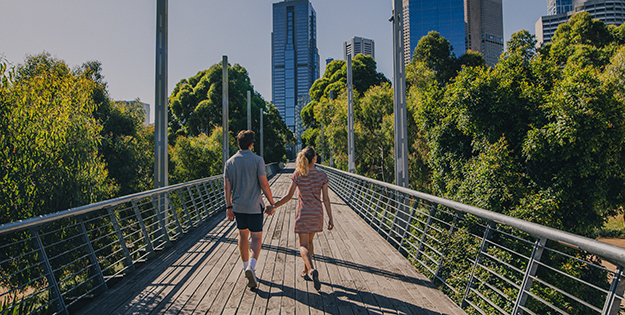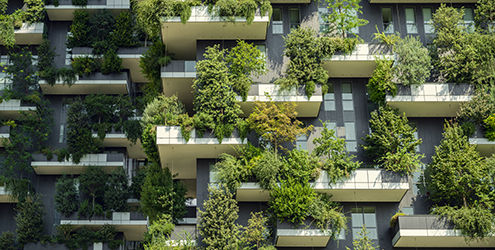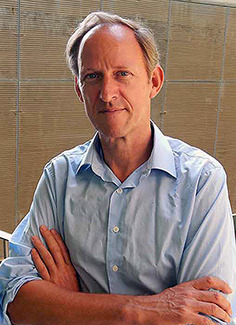Global
Copyright@ Australian Catholic University 1998-2025 | ABN 15 050 192 660 CRICOS registered provider: 00004G | PRV12008
Copyright@ Australian Catholic University 1998-2025 | ABN 15 050 192 660 CRICOS registered provider: 00004G | PRV12008

In a small community on the outskirts of Freiburg – an eco-friendly city in southern Germany – people young and old can walk and cycle in the middle of the road without worrying about being hit by a motorist.
Most streets in the neighbourhood of Vauban are completely car-free, and although a few residents still own vehicles, street parking, driveways and home garages are generally forbidden.
This has made Vauban one of the world’s greenest city districts, with better air quality, less noise pollution and more active residents.
And even without cars, life goes on.
“It’s a completely different way of living, because nowadays, for most people it’s very hard to imagine cities without cars,” says Professor Mark Nieuwenhuijsen, a leading expert in healthy urban living.
“Vauban is a wonderful place to walk around, and for those commuting to work, there’s a tram line connecting to the city centre, so there’s really no need for a car in day-to-day life.”
The lack of cars and street parking frees up space to add splashes of green to the urban landscape, cooling the surrounding area and increasing biodiversity.
“There’s a lot of sustainable housing, and there are community gardens and places where people gather and meet,” Nieuwenhuijsen adds. “Most of the time there’s not a car in sight, and it’s quiet enough to hear the birds.”
To many city-dwellers, this might sound like an urban oasis. And it’s certainly true that there are benefits to living amongst greenery.
The persistent finding in a growing body of research is that those who live in leafy neighbourhoods tend to fare much better physically, emotionally and mentally. And they’re also more likely to live longer lives.

In research that drew on nine longitudinal studies involving more than eight million people in seven countries, Professor Nieuwenhuijsen and his colleagues found living near green space can boost longevity.
The study, published in The Lancet Planetary Health, is said to be the largest analysis ever of the relationship between green space and mortality. It found that for every 10 per cent increase in greenery within 500 metres of a person’s home, their probability of early death dropped by four per cent.
“Over the last five or 10 years we’ve seen more evidence coming to the surface that shows the benefits of green space on people’s health: that it reduces the risk of premature mortality, the risk of poor mental health and things like cardiovascular disease,” says Nieuwenhuijsen, a professorial fellow at ACU’s MacKillop Institute for Health Research.
Exactly why those with access to green space tend to live longer is not yet clear. But the research team does have a theory: simply looking at plants and trees helps to lower the level of the stress hormone cortisol in the blood.
“This seems to be an important mechanism because when we’re around green space, we tend to relax,” Nieuwenhuijsen says. “That results in a significant amount of stress reduction and restoration, which we know has a whole range of health benefits.”
In an earlier review titled Fifty Shades of Green: Pathway to Healthy Urban Living, Professor Nieuwenhuijsen and his colleagues referenced the term “biophilia”, coined in the 1980s by Harvard professor Edward Wilson to explain our natural affinity for plants and trees.
“For tens of thousands of years humans have lived in forests and savannahs surrounded by nature, and only during the past few thousand years they have moved into cities, where nature is often less available,” the study says.
That’s a very short time from an evolutionary perspective, Nieuwenhuijsen adds, and we still seem to find comfort in the colours – and the shapes – of nature.
“When we build cities, often they’re very grey, and they’re very square and straight, and our brains are not really used to that,” he says. “We’ve not properly evolved and adapted to live in these artificial environments that are not so nice.”
Some researchers have looked specifically at the effects of both green and grey space on the brain. In a study led by environmental scientist Greg Bratman, participants who took a short walk through nature were happier, more attentive and less anxious than those who walked for the same amount of time in city streets.
This should be of great concern to all of us, says Nieuwenhuijsen, because almost half of the world’s population currently lives in cities, and the proportion is set to increase rapidly to 70 per cent in the coming years.
“I don’t think we’re prepared for the negative effects on health that might have on millions of millions of people,” he says.
“We know for sure that poor or suboptimal urban and transport planning has a very negative impact on health, but for the most part, if you look around the world, we’re still building cities that are really grey, and where people have to commute a very long way to get to work.”
There are, of course, exceptions to the rule.
As well as the Vauban neighbourhood in Freiburg, Germany boasts some of the world’s greenest urban areas, with almost 70 per cent of its largest cities taken up by green space.
Meanwhile, their neighbour the Netherlands has pioneered the woonerf, a “living street” where pedestrians and cyclists have legal priority over motorists, and where shrubs and gardens often take the place of street parking.
But there’s more to a green city than plants and trees. Eco-friendly urban areas need a range of transport options that take cars off roads, resulting in better air quality and a more mobile population.
This is where Australia’s larger urban centres fall short, says Professor Nieuwenhuijsen. Our sprawling cities are way too car-focused, with not enough public and active transport.
“Here in Melbourne, it’s fairly green, but because it’s so spread out, many people have a very long commute, which means they spend a lot of time not being active,” he says.
“When a city is built with a lot of infrastructure for cars, like parking and roads, that creates a range of problems like air pollution, noise and heat island effects, which are all associated with poor health outcomes.”
The compact and walkable nature of some of Europe’s greener city neighbourhoods gives them a clear advantage over our spread-out urban areas.
Vauban, for example, has a population density of 136.5 people per hectare. Compare that to Melbourne, where just 3.1 per cent of residents live at a density of over 100 people per hectare.
For better or worse, rising urban density is still viewed with great suspicion amongst Australian city-dwellers, with talk of “shoeboxes” or “urban slums”.
“I think there is definitely a perception in Australia that compact and dense cities are all about people living in skyscrapers, and that’s not what I’m talking about when I say ‘compact’,” Nieuwenhuijsen says.

“I’m talking about buildings that are only five or six floors high, and they’re built in a sustainable way, with lots of trees planted around them and in between, and communal gardens as well. Because it’s true that going high-rise is not very pleasant – you end up with a lot of concrete, which we know creates a range of problems.”
The case for “urban greening” has been building for several decades, but it’s only in recent years that the evidence has stacked up to support its links to better health.
While the tension between profit, people, practicality and the planet remains, local planners and legislators seem much more willing to act.
“Doing these large-scale studies and having the numbers to put on the table is quite powerful when you’re speaking to planners in different levels of government,” Professor Nieuwenhuijsen says.
“We didn't have that before, and if you’re suddenly able to say, ‘Hey, if you put green space here, you can prevent 100 premature deaths per year’, they say, ‘Wow, that’s important, we must do that’, and it’s very hard for them to ignore.”
For most of the year, Nieuwenhuijsen is based in Spain as a director at Barcelona’s Institute for Global Health. He’s become a strong advocate for the city’s superilles model, which has seen the reclaiming of streets devoted to cars as shared public spaces.
Currently, six “superblocks” have been created in Barcelona, with the first in the Poblenou neighbourhood near the city centre. The model uses a range of techniques to limit the passage of vehicles through urban neighbourhoods, opening up public space for walking and recreation.
Nieuwenhuijsen and his colleagues found the city could prevent up to 700 premature deaths a year if it fully implements its plan, while also helping to mitigate effects of climate change.
He believes such a model could work perfectly in Australia’s traffic-choked CBDs, allowing the people – and the plants – to reclaim the streets.
“It’s all about reducing the space that’s given to cars and giving it back to the people, and I think it’s something that could be implemented in cities like Melbourne, to reduce car use, put in more green space, and have a much healthier environment,” he says.
He hopes the examples set by places like Vauban and Barcelona will prompt other cities to look for green alternatives to sprawling, car-dominated urban centres.
“When you see what a city looks like without cars, and with more green space, it opens up your imagination to what our future cities can be,” Nieuwenhuijsen says.
“If we go back to the idea of putting people in the centre of the development of our cities, that would help to create clean, functional places with citizens who are healthier, more active and closer to nature, just like we are meant to be.”
Professor Mark Nieuwenhuijsen is a world-leading expert in environmental exposure assessment, epidemiology, and health risk and impact assessment, with a strong focus and interest on healthy urban living. He is director of Urban Planning, Environment and Health at ISGlobal in Barcelona and a professorial fellow at ACU in Melbourne.

Copyright@ Australian Catholic University 1998-2025 | ABN 15 050 192 660 CRICOS registered provider: 00004G | PRV12008